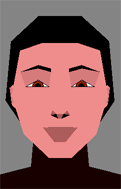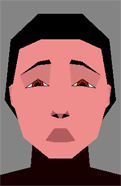
This condition is of little significance in ordinary life (threading a needle might be harder), and (unless you are a pilot or a habitual needle-threader) you may well be stereo-bind without realizing it.
To test your stereo vision, look at the following figure through red-blue glasses, with the blue filter over your right eye. If you see a group of circles hovering in the foreground and forming a large digit your stereo vision is fine. Otherwise it may be impaired. Since this condition is uncorrectable you may as well ignore it, but you can chat about it with interested friends. And do send me an E-mail so I can see if stereo blindness is as common as I think.

Here is a second test image, but one that is a bit more difficult to see. Look at it through red-blue glasses, with the blue filter over your right eye. If, after a few seconds, you see a large letter hovering in the foreground, your stereo vision is good.

Here is a third image which can be used as a stereo vision test, but which also demonstrates another interesting property of stereo vision. Look at it through red-blue glasses, with the blue filter over your right eye. The figure on the left will appear farther forward than the one on the right. holding the glasses with one hand, you can 'pinch' it with th fingers of your other hand to associate a more conventional physical depth with the depth perceived through the glasses.

Note also that, viewed through the glasses,the figure on the left seems to be distinctly smaller than that on the right. Since you can easily see by looking at the figure without glasses that the images formed on the retina by the left and right figures must be of equal size, this perception must be generated by the binocular vision system. You can test this conclusion by reversing the glasses; now the figure on the left appears farther back then the right-hand figure, but also larger. So it seems that the binocular vision system is automatically (and subconsciously) adjusting the perceived size of objects in a way that makes physical sense, namely by reducing the perceived size of objects if they are thought to be closer to the viewer.
These observations suggest that crippling neuroses can easily rise from miscalibrated emotional (rather than visual) perceptions. We have sophisticated (and little understood) mechanisms for perceiving the emotional state of people around us, to know whether they are happy, sad, angry, or threatening; attentive or bored; respectful or sneering; candid or concealing something. As shown by the following series of cartoon faces (provided courtesy of Ken Perlin) many of these perceptions arise from fine details of facial expression.





Miscalibration of the mechanisms of emotional perception can easily lead to disturbed views such as 'Nobody respects or likes me', 'Everybody is angry at me all the time but trying to conceal the fact'. 'People are in secret communication about something', and so forth. Such perception may be as hard to overcome as the perception of reduced size generated by the third figure above.